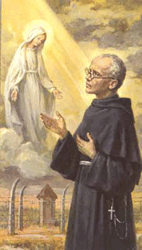Witnesses to Hope
 On August 14, 1941, Father Maximilian Kolbe traded his life for that of another prisoner in the Auschwitz-Birkenau concentration camp. One year later, a young chemical plant worker by the name of Karol Wojtyla began seminary studies as an “underground” seminarian. It was three years after World War II began in Europe with Germany’s invasion of Poland.The Archdiocese of Krakow, the diocese for which Karol Wojtyla studied to be a priest in the midst of war, also included Auschwitz-Birkenau’s starvation bunker where Maximilian’s life ended in sacrifice after weeks of starvation. Twenty-three years later, Karol Wojtyla would become the Archbishop of Krakow.In Witness to Hope, the magnificent epic biography of Pope John Paul II, George Weigel describes in moving detail the vast spiritual influence Saint Maximilian’s life and death had on the life and priesthood of Karol Wojtyla.As the “Saint of the Abyss,” a title ascribed to Maximilian by biographer Andre Frossard (Forget Not Love: The Passion of Maximilian Kolbe, Ignatius 1991), Maximilian was, for our late Holy Father,
On August 14, 1941, Father Maximilian Kolbe traded his life for that of another prisoner in the Auschwitz-Birkenau concentration camp. One year later, a young chemical plant worker by the name of Karol Wojtyla began seminary studies as an “underground” seminarian. It was three years after World War II began in Europe with Germany’s invasion of Poland.The Archdiocese of Krakow, the diocese for which Karol Wojtyla studied to be a priest in the midst of war, also included Auschwitz-Birkenau’s starvation bunker where Maximilian’s life ended in sacrifice after weeks of starvation. Twenty-three years later, Karol Wojtyla would become the Archbishop of Krakow.In Witness to Hope, the magnificent epic biography of Pope John Paul II, George Weigel describes in moving detail the vast spiritual influence Saint Maximilian’s life and death had on the life and priesthood of Karol Wojtyla.As the “Saint of the Abyss,” a title ascribed to Maximilian by biographer Andre Frossard (Forget Not Love: The Passion of Maximilian Kolbe, Ignatius 1991), Maximilian was, for our late Holy Father,
“the man who looked straight into the modern heart of darkness and remained faithful to Christ by sacrificing his life for another…” (Witness to Hope, p. 447).
At the canonization of Blessed Maximilian on October 10, 1982 – barely four months after I was ordained a priest – a theological question arose over whether Father Maximilian could properly be canonized as a martyr. Though no one doubted that he was a martyr of charity, some theologians were unclear over whether his martyrdom was a direct result of “odium fidei,” hatred of the faith.In a nod to the “sensus fidelium,” the sense of the faith of many Catholic Poles, Germans and others so harmed by the war, and so inspired by the acts of Father Maximilian, the Holy Father declared him a martyr of “odium hominis,” of systematic hatred of the human person (Witness to Hope, p. 448).Pope John Paul II and the Catholic faithful were not alone in this special recognition of Father Kolbe’s sacrificial witness to hope. In his stunning and deeply moving book, People of Auschwitz, published in association with the United States Holocaust Museum, Auschwitz survivor and historian Hermann Langbein wrote:
“The best known act of resistance was that of Maximilian Rajmund Kolbe, who deprived the camp administration of the power to make arbitrary decisions about life and death.”
In June, 1979, Pope John Paul II knelt on the floor of Cell 18 in Block 11, the spot at Auschwitz in which Maximilian surrendered his life. When the Holy Father stood, he embraced 78-year-old Franciszek Gajowniczek, the man who lived because of Maximilian’s gift. Pope and former prisoner had been witnesses to the horror wrought by war and the hope forged in the crucible of sacrifice.Hope won. Hope built upon sacrifice always does.On August 14, may St. Maximilian bless you and inspire you to hope.[See “Maximilian Kolbe and the Man in the Mirror” and “Maximilian and This Man’s Search for Meaning.”]
